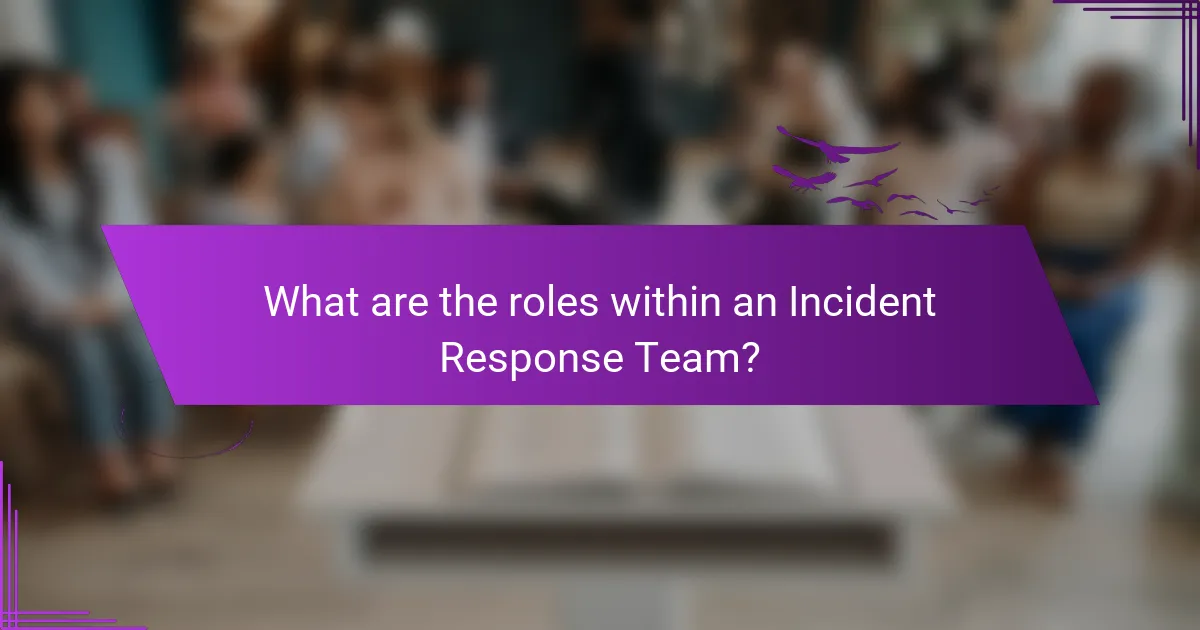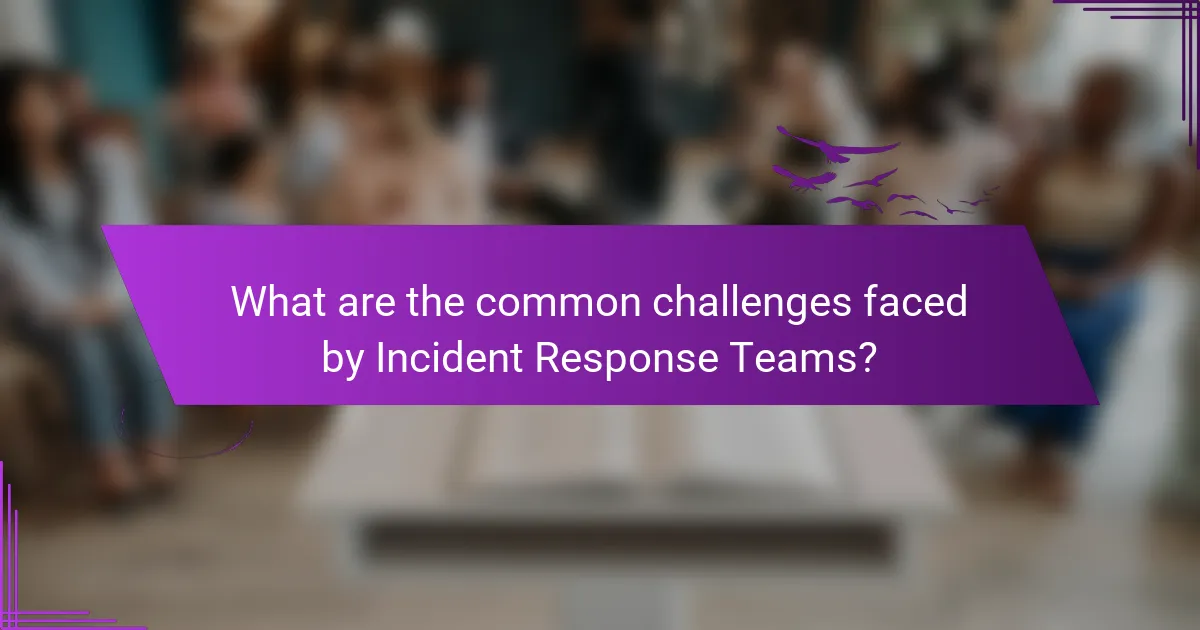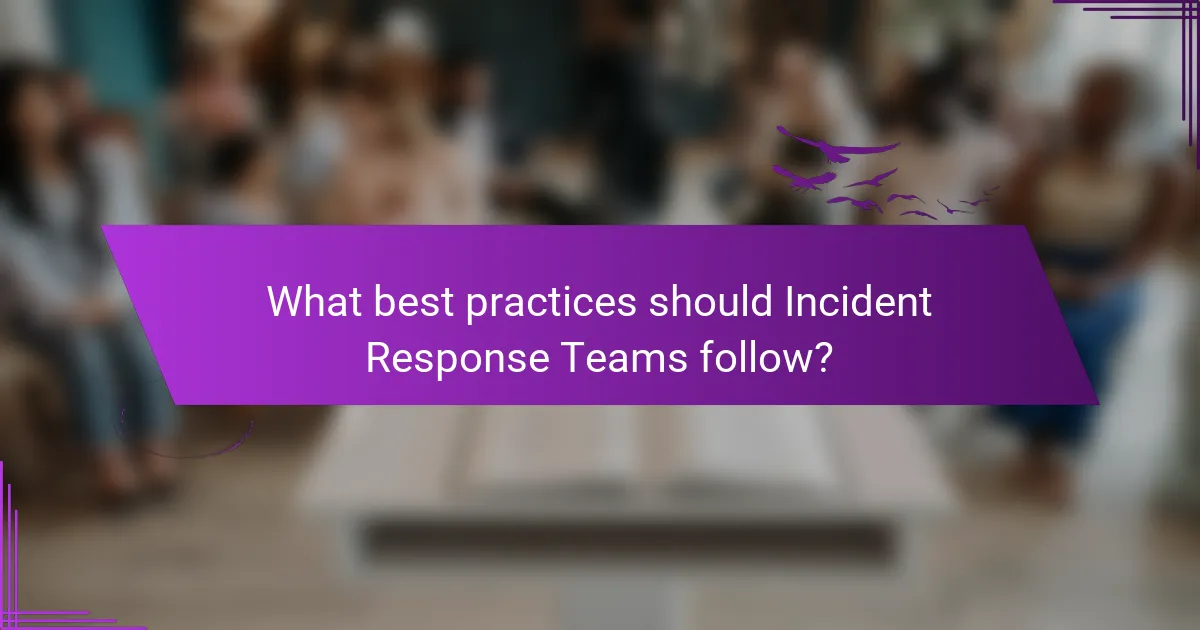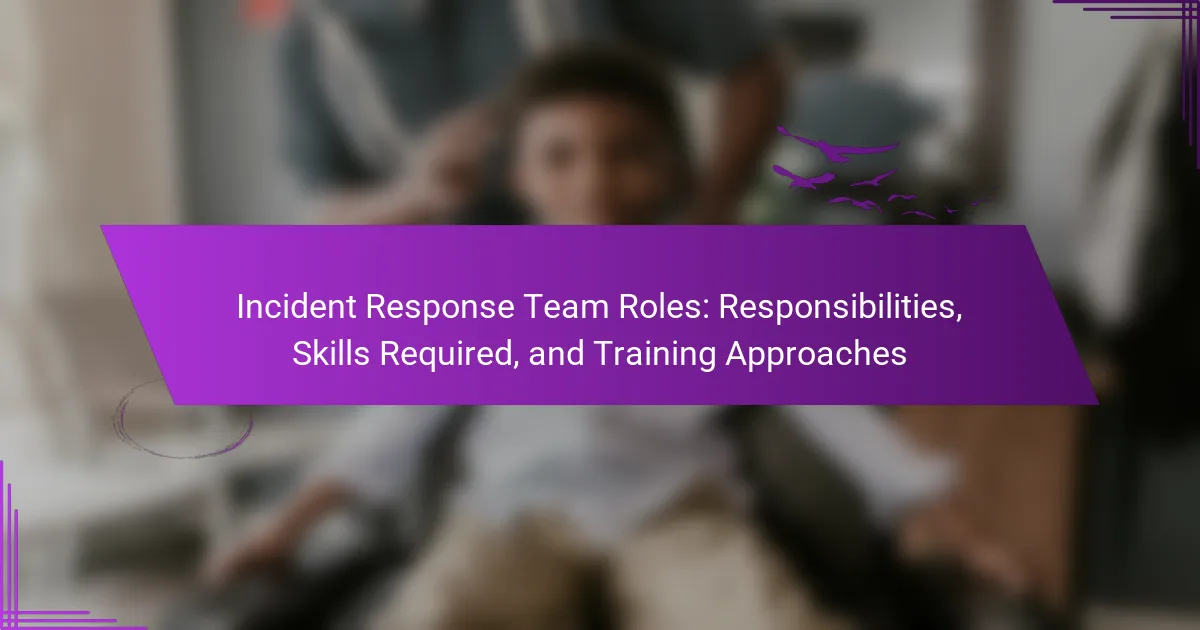
What are the roles within an Incident Response Team?
An Incident Response Team (IRT) includes several key roles essential for effective incident management. The roles typically consist of an Incident Response Manager, who oversees the entire response process. There are also Analysts, responsible for investigating and analyzing incidents. Forensic Experts collect and preserve evidence from incidents. Communication Officers handle internal and external communications during an incident. Additionally, Legal Advisors ensure compliance with laws and regulations. Each role contributes to a coordinated response, which is critical for minimizing damage and restoring operations. These roles are defined to ensure comprehensive coverage of incident response activities.
How are these roles defined and categorized?
Incident response team roles are defined based on specific responsibilities and skill sets. These roles typically include incident commander, security analyst, forensic analyst, and communications officer. The incident commander oversees the response process, ensuring coordination among team members. Security analysts assess and mitigate security threats during incidents. Forensic analysts investigate breaches and gather evidence for analysis. Communications officers manage internal and external communication regarding incidents. Each role is categorized by its unique functions and required expertise, ensuring a comprehensive approach to incident management.
What are the primary responsibilities of each role?
The primary responsibilities of each role in an Incident Response Team include the following. The Incident Response Manager oversees the entire incident response process. This role ensures proper coordination and communication among team members. The Security Analyst investigates security incidents and analyzes data for threats. They are responsible for identifying vulnerabilities and recommending remediation. The Forensic Expert collects and preserves evidence during an investigation. They provide detailed analysis to support legal or organizational actions. The Threat Hunter proactively searches for potential threats within the network. This role focuses on identifying and mitigating risks before they escalate. The Communication Officer manages internal and external communications during incidents. They ensure that stakeholders are informed and that messaging is consistent. Each role has distinct responsibilities that contribute to the overall effectiveness of the incident response process.
How do these roles interact during an incident?
During an incident, roles within an incident response team interact through a coordinated effort. The incident commander oversees the response and ensures effective communication. Team members, such as analysts and responders, report to the commander with updates and findings. Analysts gather data and assess the situation, while responders implement containment strategies. Each role relies on the others for timely information sharing. This interaction is crucial for swift decision-making and effective incident management. The National Institute of Standards and Technology (NIST) emphasizes the importance of collaboration among team roles to enhance incident response effectiveness.
What skills are essential for each role in an Incident Response Team?
An Incident Response Team (IRT) requires specific skills for each role. For the Incident Response Manager, leadership and communication skills are essential. This role coordinates the team and communicates with stakeholders. The Security Analyst must possess analytical skills and technical knowledge of security tools. They assess threats and analyze incidents to determine impact. The Forensic Analyst needs expertise in digital forensics and evidence collection. They gather and analyze data from compromised systems. The Threat Intelligence Analyst should have skills in threat modeling and research. This role identifies potential threats and provides actionable intelligence. The Incident Responder must excel in problem-solving and technical skills. They execute the response plan and mitigate incidents effectively. Each role contributes to a cohesive response strategy, enhancing overall security posture.
Why is technical expertise important for incident responders?
Technical expertise is crucial for incident responders because it enables them to effectively analyze and mitigate security incidents. This expertise allows responders to understand complex systems and identify vulnerabilities. With technical knowledge, they can quickly assess the scope of an incident and implement appropriate responses. Furthermore, expertise in relevant tools and technologies enhances their ability to contain threats and recover systems. According to a study by the SANS Institute, 90% of organizations reported that technical skills are vital for incident response effectiveness. This highlights the necessity for responders to possess both theoretical knowledge and practical skills in cybersecurity.
What soft skills enhance team effectiveness during incidents?
Effective communication enhances team effectiveness during incidents. Clear communication fosters understanding and coordination among team members. Active listening allows team members to grasp critical information quickly. Emotional intelligence helps in managing stress and maintaining morale. Adaptability enables teams to respond to changing situations efficiently. Collaboration promotes teamwork and shared problem-solving. Conflict resolution skills help to address disagreements constructively. These soft skills collectively improve decision-making and response times during incidents.
How does training influence the effectiveness of an Incident Response Team?
Training significantly enhances the effectiveness of an Incident Response Team (IRT). It equips team members with essential skills to identify, analyze, and mitigate security incidents. Regular training ensures that the team remains updated on the latest threats and response techniques. This preparedness leads to quicker response times during incidents.
Moreover, training fosters teamwork and communication among team members. Effective communication is crucial during high-pressure situations. A well-trained team can coordinate actions seamlessly, reducing the chances of errors.
Research indicates that organizations with regular incident response training have 30% faster recovery times from breaches. This statistic underscores the critical role of training in improving response capabilities. Overall, comprehensive training is vital for the operational success of an IRT.
What types of training programs are available for incident responders?
Incident responders can participate in various training programs. These programs include technical training, which focuses on specific tools and technologies used in incident response. Additionally, tabletop exercises simulate real-world scenarios to enhance decision-making skills. Live drills provide hands-on experience in managing incidents under pressure. Furthermore, online courses offer flexibility and cover foundational knowledge in incident response. Certifications, such as Certified Incident Handler (GCIH), validate skills and knowledge in the field. Specialized training may also focus on specific industries or regulatory compliance. Each program aims to equip responders with the necessary skills to effectively manage incidents.
How often should training be conducted to ensure readiness?
Training should be conducted regularly, ideally quarterly, to ensure readiness. Regular training helps maintain skills and knowledge among team members. It also ensures that the team is familiar with updated protocols and technologies. Research indicates that frequent training enhances performance during actual incidents. For example, a study by the National Institute of Standards and Technology (NIST) emphasizes the importance of ongoing training for effective incident response. This study highlights that teams that train more frequently are better prepared to handle emergencies.

What are the common challenges faced by Incident Response Teams?
Incident Response Teams face several common challenges. One major challenge is the lack of resources, including personnel and technology. Many teams operate with limited budgets, which restricts their ability to invest in advanced tools. Another challenge is the high volume of alerts and incidents, making it difficult to prioritize and respond effectively. Additionally, team members often experience burnout due to the demanding nature of incident response work. Communication issues can arise, especially in large organizations, leading to delays in response times. Furthermore, staying updated with evolving threats and vulnerabilities poses a significant hurdle. Training and skill gaps within the team can hinder effective incident management. Lastly, the need for collaboration with other departments can complicate the response process.
How do team dynamics affect incident response?
Team dynamics significantly impact incident response effectiveness. Cohesive teams communicate better, leading to quicker decision-making during incidents. Trust among team members fosters collaboration, which is crucial for problem-solving. Diverse skill sets within a team enhance adaptability to various incident scenarios. Research indicates that effective teamwork reduces response times by up to 25%. Additionally, well-defined roles within a team minimize confusion and streamline operations. Poor team dynamics can lead to misunderstandings, resulting in delayed responses. Overall, strong team dynamics are essential for efficient incident management.
What strategies can improve communication within the team?
Implementing regular team meetings can improve communication within the team. These meetings foster open dialogue and ensure everyone is aligned on objectives. Utilizing collaborative tools like Slack or Microsoft Teams enhances real-time communication. Establishing clear communication protocols reduces misunderstandings and streamlines information sharing. Encouraging feedback creates a culture of transparency and trust. Active listening training can enhance interpersonal skills among team members. Setting up defined roles clarifies responsibilities and prevents overlap in communication. Lastly, team-building activities strengthen relationships and improve overall collaboration.
How can teams manage stress and burnout during high-pressure incidents?
Teams can manage stress and burnout during high-pressure incidents by implementing structured support systems. Regular breaks can help mitigate fatigue and improve focus. Encouraging open communication fosters a supportive environment. Utilizing stress management techniques, such as mindfulness or breathing exercises, can enhance resilience. Providing access to mental health resources is crucial for team well-being. Research indicates that organizations with strong support systems report lower burnout rates. A study by the American Psychological Association found that effective stress management strategies significantly improve team performance during crises.
What technological tools support Incident Response Teams?
Technological tools that support Incident Response Teams include Security Information and Event Management (SIEM) systems, endpoint detection and response (EDR) tools, and threat intelligence platforms. SIEM systems aggregate and analyze security data from various sources. They help teams identify and respond to incidents in real-time. EDR tools provide visibility into endpoint activities. They enable teams to detect, investigate, and remediate threats on devices. Threat intelligence platforms offer insights into emerging threats. They assist teams in understanding the threat landscape and improving response strategies. Together, these tools enhance the overall effectiveness of Incident Response Teams.
Which software solutions are critical for effective incident management?
Critical software solutions for effective incident management include ticketing systems, communication platforms, and monitoring tools. Ticketing systems like ServiceNow or JIRA help track and manage incidents efficiently. Communication platforms such as Slack or Microsoft Teams facilitate real-time collaboration among team members. Monitoring tools like Splunk or Nagios provide visibility into system performance and alert teams to potential issues. These solutions streamline workflows and enhance response times during incidents. Their adoption leads to improved coordination and accountability within incident response teams.
How do automation tools enhance response efficiency?
Automation tools enhance response efficiency by streamlining and accelerating incident management processes. They enable faster detection of issues through real-time monitoring and alerting. Automation reduces manual intervention, thereby minimizing human error. Tools can automatically categorize and prioritize incidents based on predefined criteria. This prioritization allows teams to focus on critical issues first. Automated workflows facilitate quicker resolution by guiding responders through established protocols. Additionally, these tools can generate reports and insights instantly, aiding in post-incident analysis. Research indicates that organizations using automation tools can reduce response times by up to 50%.

What best practices should Incident Response Teams follow?
Incident Response Teams should follow several best practices to effectively manage incidents. First, they must establish a clear incident response plan. This plan should outline roles, responsibilities, and procedures. Regular training and simulations are essential to prepare team members for real incidents. Documentation of all incidents and responses helps in learning and improving future responses. Communication with all stakeholders is vital during an incident. Teams should also prioritize containment, eradication, and recovery to minimize damage. Continuous monitoring and updating of security measures are necessary to prevent future incidents. Lastly, conducting post-incident reviews allows teams to assess their performance and make necessary adjustments.
How can teams develop a comprehensive incident response plan?
Teams can develop a comprehensive incident response plan by following a structured approach. First, they should define the scope and objectives of the plan. This includes identifying potential incidents that could affect the organization. Next, teams must establish roles and responsibilities for each member involved in the response. Clear communication protocols should be outlined to ensure effective coordination during an incident.
Additionally, teams should conduct a risk assessment to prioritize incidents based on their potential impact. Regular training and simulations are essential for preparing the team to respond effectively. Incorporating feedback from these exercises helps refine the plan. Finally, the incident response plan should be reviewed and updated periodically to adapt to new threats and organizational changes.
What elements are essential for a successful incident response plan?
A successful incident response plan requires clear roles and responsibilities. Each team member must understand their specific tasks during an incident. Communication protocols are essential for effective coordination. Documentation of incidents and responses aids in future analysis. Regular training ensures team readiness for real incidents. A review process is necessary to update the plan based on lessons learned. Additionally, having a designated incident commander helps streamline decision-making. Finally, integrating threat intelligence enhances the plan’s effectiveness against evolving threats.
How can regular drills improve team preparedness?
Regular drills enhance team preparedness by providing practical experience in responding to incidents. They allow team members to practice their roles in a controlled environment. This repetition builds muscle memory and familiarity with procedures. Teams can identify weaknesses in their response strategies during these drills. Regular drills also improve communication among team members. Effective communication is crucial during real incidents. According to the National Institute of Standards and Technology (NIST), frequent drills can reduce response times significantly. Drills encourage collaboration and trust within the team. Overall, they create a culture of readiness and resilience.
What are the key takeaways for building an effective Incident Response Team?
An effective Incident Response Team (IRT) requires clear roles and responsibilities. Each member should have specific duties aligned with their expertise. Regular training and simulations enhance preparedness for real incidents. Communication protocols must be established to ensure quick information sharing. Strong leadership is essential for decision-making during crises. Documentation of incidents aids in learning and improving future responses. Collaboration with other departments strengthens the overall security posture. Continuous improvement through feedback loops ensures the team evolves with emerging threats.
How can organizations foster a culture of continuous improvement in incident response?
Organizations can foster a culture of continuous improvement in incident response by implementing regular training and post-incident reviews. Training should focus on enhancing skills and knowledge relevant to incident management. Post-incident reviews allow teams to analyze responses and identify areas for improvement.
Encouraging open communication is also vital. Teams should feel safe sharing insights and mistakes without fear of blame. This transparency leads to collective learning and better preparedness for future incidents.
Additionally, organizations can adopt metrics to evaluate incident response effectiveness. Tracking response times and resolution rates provides data for informed decision-making. Continuous feedback loops can be established to adapt strategies based on performance.
Investing in tools that support incident management can enhance efficiency. Automation can streamline processes and reduce human error. Finally, fostering a mindset of adaptability ensures teams are prepared for evolving threats.
What resources are available for ongoing learning and development in incident response?
Resources for ongoing learning and development in incident response include online courses, certifications, and industry conferences. Online platforms like Coursera and Udemy offer courses on incident response techniques. Certifications such as Certified Incident Handler (GCIH) and Certified Information Systems Security Professional (CISSP) validate expertise in the field. Industry conferences like Black Hat and DEF CON provide networking and learning opportunities. Additionally, organizations like SANS Institute offer training programs focused on incident response. These resources help professionals stay updated on best practices and emerging threats.
Incident Response Team (IRT) roles encompass various responsibilities critical for effective incident management, including the Incident Response Manager, Analysts, Forensic Experts, Communication Officers, and Legal Advisors. Each role is defined by specific skills and functions, facilitating coordinated responses during security incidents. The article explores the essential skills required for each position, the interaction dynamics within the team, and the importance of training in enhancing response capabilities. Additionally, it addresses common challenges faced by IRTs and offers best practices for developing a comprehensive incident response plan, ensuring organizations are well-prepared for potential incidents.
